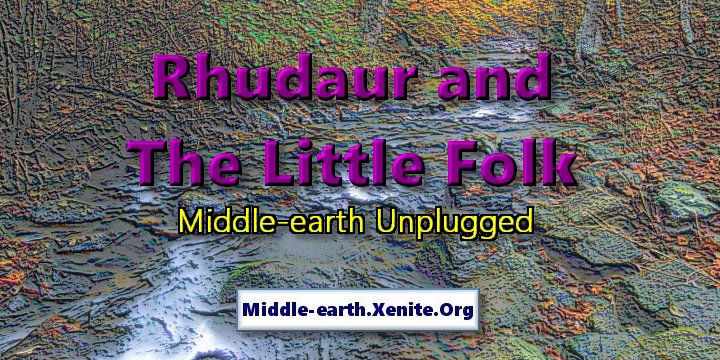
Almost 200 years ago the sons of High King Eärendur divided the former realm of Arnor between themselves. Amlaith, the eldest, defiantly asserted his claim to rule all of the northern Dunedain by naming his realm Arthedain. The younger princes, sometimes called Harmuindor (“South Brother”) and Rhumuindor (“East Brother”), established the kingdoms of Cardolan (“Land of Red Hills”) and Rhudaur (“Evil Forest”) respectively. Among the common folk and those who wish not to offend any princes who may be in earshot the three royal families are sometimes named Cardh Forod (“the North House”), Cardh Harad (“the South House”), and Cardh Rhun (“the East House”).
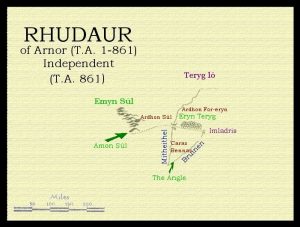
Among the kings self-proclaimed unofficial titles such as Isildurioni, Isildurchil, and Isildured may be heard. They do not invoke the name of Elendil in these pretentious titles, however, perhaps out of concern for the sensibilities of the Kings of Gondor. More often when the kings address each other if they are being formal they may say Aran Forodren (“the Northern King”), Aran Haradren (“the Southern King”), or Aran Rhunen (“the Eastern King”). In rare moments of informal converse they may refer to each other as Forodtôr (“north-brother”), Haradtôr (“south-brother”), and Rhuntôr (“east-brother”). However, to call the King of Rhudaur Rhutôr(“evil-brother”) is a grave insult.
The Rhunen Erain are perhaps the most proud and arrogant of the Dunadan kings if only because their realm has historically had the fewest Dunedain among their peoples. Until recently the greater part of the folk of Rhudaur have been drawn from the hill-clans, ancient tribes who dwelt in the foot-hills of the mountains north of Imladris. They were not particularly hostile to Lord Elrond and his Elvish folk but neither have they been the warmest of friends to the Elves. Caras Bennas (“(fortified) City of the Angle”) counts few hill-men among its citizens. The city is small and is more like a fortress than an actual city, but one learns quickly not to use the term Barad Bennas within hearing of the Dunedain. Ironically, it may be acceptable to speak of Aran Baradif speaking of the king’s home.
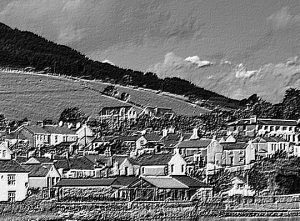
Confusing as all this may seem, imagine what it must be like for the newcomers to absorb all of these pretentious political panderings. They are simple folk, farmers for the most part, who speak an ancient form of Adûnaic akin to the dialects of the Free Men of the Vales of Anduin. Standing only about half the height of a tall Numenorean man, these Little Folk call themselves Groba-Timrjaz or “hole-builders”. The Dunedain have welcomed them with warm smiles. The hill-folk seem only to look down upon them (which is ironic, given that the hill-men are not accounted very tall among the peoples of Eriador).
Protected by the Army of Rhudaur, the Groba-Timrjaz people have been encouraged to settle in the wide lands between Mitheithel (“the Hoarwell” or “Greyflood”) and Emyn Sûl (“the Weather Hills”). The lightly wooded area is suitable for farming and the pasturing of sheep, cattle, horses, and the occasional pig. The Emyn Sûl may be favored by goats. And the occasional warring army.
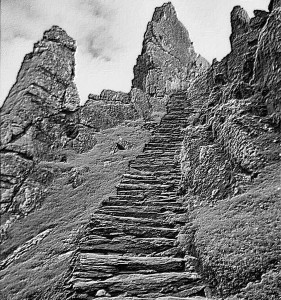
Emyn Sûl, of course, stands along the border between Rhudaur and Arthedain — that is, the North Kingdom. The two realms barely tolerate each other most years. Every now and then they test each other’s mettle. Because the North Kingdom’s forces patrol the gap between the North Downs and the Weather Hills and because Cardolan, sometimes referred to as “the Other Kingdom”, maintains forces on or near Amon Sûl (“Weathertop”) the Little Folk are constrained dwell only near the center of the Emyn Sûl or in the forested lands eastward to the Mitheithel.
They came over the mountains only a few years ago, fleeing wars in the Vales of Anduin. The Free Men of the North have been assailed by Easterlings. Thranduil, King of the Silvan Elves of Greenwood the Great, has led his people into the northern forest. The Longbeard Dwarves of Moria now use Cirith Forn en Andrath (“the High Pass of the North”) much more often than in olden days. The loss of so many trading partners in the Vales of Anduin has forced them to look westward.
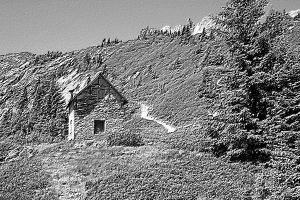
The Little Folk are hardy and valiant at need but they are peaceful. They have freely accepted lands between Mitheithel and Emyn Sûlnorth of the Great Road despite the threat of incursions from the wild areas north of Rhudaur. The untamed tribes of Men and dark creatures that sometimes wander into Rhudaur force the kings to maintain a line of forts across the northern border. The farms and villages of the Little Folk stretch in a thin line across western Rhudaur. They barely maintain their thin roads but their crops and trade have reinvigorated Rhudaur.
The Little Folk live in large family groups, often 100-150 together in small enclaves. Where they can dig their homes under hills they establish themselves quickly. A few clans have adapted to the open countryside. They settle near the few villages of Men, enjoying the friendship and protection of the Big Folk. Each family has a Master, a clan-chief, who speaks for them all at the local moots. The moots receive the king’s messengers and fulfill the families’ obligations to the monarchy.
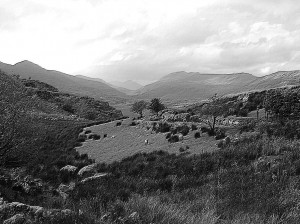
Their needs are simple. Every year new land is broken. New roads are cut through the woodlands to connect the farms and villages. They welcome Dwarven traders but the Dunadan lords of Rhudaur have also made arrangements to purchase wool, food, and such small crafts as the Little Folk can provide. They require little metal and do not love to travel. In fact, they largely keep to their own lands and only rarely visit Bennas Rhudaur (“the Angle” between Mitheithel and Bruinen). It is almost unheard of that they travel back over the mountains, although a few wanderers from among their kin have come down into Rhudaur from the east.
When speaking of all Groba-Timrjaz the Little Folk of Rhudaur call themselves Hasafotuns. Some people say this is because they are fleet of foot and can vanish quickly into the brush if they do not wish to be seen. Others say it is because they have feet like hares. The word is drawn from the language of the Free Men of the North, perhaps more similar to those on the eastern side of Anduin than near the mountains. The Hasafotuns tell us there are others still living in the east who are of different kinds or tribes.
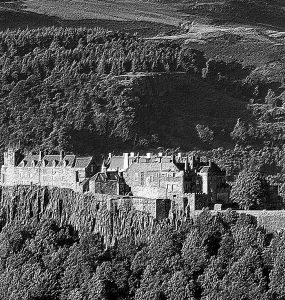
The Fal-huljaniz are the tallest and lightest skinned among the Little Folk. They are more adventurous than the others and the wanderers who enter Rhudaur singly or in small groups are often drawn from the Fal-huljaniz clans in the east. Some of them speak a rustic Elven tongue, perhaps the language of the Silvan Elves from Greenwood — perhaps a blend of Mannish and Elvish words. It is from the Fal-huljaniz that word has reached Eriador of mysterious creatures called draugar. The Lambengolmor of Caras Bennas say the word may mean something like “phantom” or “ghost”, but there is a dread associated with the name such that they think it refers to something more than a mere haunt.
The third group of Little Folk are called the Sturi, which our Lambengolmor say means something like “the strong ones”. They are larger than the Fal-huljaniz and live close to the Great River. The Sturi may be mistaken for very young Dwarves, except for their lack of beards. They are more likely to live above ground than the more numerous Hasafotuns and the slender Fal-huljaniz. Whereas the Hasafotuns borrow many words from the Dwarves, the Sturi seem to favor Mannish languages the most.
Their names for themselves are just as strange as the names of their tribes. One clan call themselves the Thahsusaz or “badgers”. Another clan call themselves Karpaz, “carps” (for the fish). Another clan is called the Balgs-deganiz, the “wine-skin makers”. Goat-herding families are often called Bukksiz. These are the older forms of the names. Some of the clans use a softer speech, changing the pronunciation of the old words according to the customs of the Elves or Dwarves.
The families do have special skills. There are rope-makers, wine-growers, farmers, hunters, fishers (a rare skill), and others. They trade their specialties with each other. Some of the more common names are said to stem from large family groups that broke up one or more generations ago. Although few of the Little Folk write at all, the family groups remain in close communication with each other. They do not wander far when establishing new farms or villages.
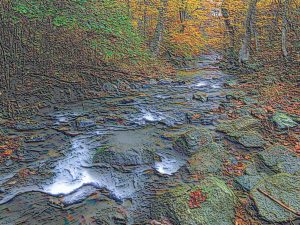
Much like Elves and Men the Little Folk love song. Their songs are strange, slow and sonorous. They do not sing of war or the great deeds of warriors and kings. Their songs are filled with the joy they find in the world around them. They may sing about butterflies or dancing sheep. They may sing about rivers walking across the land. It is almost as if they want to lose themselves in the merry ideas of children. Indeed, but for the serious attitude of the elders one might mistake them for children from a distance.
It is said that when a party of Cardolan soldiers raided the western shire of Ardhon Sûl a few years ago, perhaps seeking to create mischief among the farmers who were brave enough to live near Amon Sûl, they were dumbfounded by the little farmer folk who ignored their approach. Accustomed to seeing the folk of Rhudaur flee before them, the soldiers entered the westernmost village of the Hasafotuns (now removed farther north for safety) and the clan chief promptly offered them tea. The soldiers returned to Cardolan with neither booty nor pride.
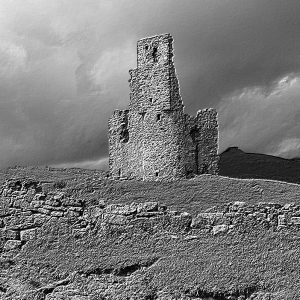
Anecdotes about the Little Folk abound throughout the east. Dunadan scholars have visited Caras Bennas from Arthedain, Cardolan, and Rhudaur to inquire into their care and keeping. It is perhaps amusing to the Rhunen Erain to see their cousins so curious about such an unwarlike folk. Few if any of the scholars have crossed the mountains to contact the other tribes of Groba-Timrjazbut should any Free Man of the North visit Rhudaur or Calenardhon he is lashed with questions about the Little Men Who Dwell by the Great River.
No one knows their place of origin. “From the east,” they say simply in their strange accent if you ask them where their fathers came from. A loremaster from Gondor says their speech resembles that of the Northmen who live beyond Greenwood the Great; and yet he notes a few differences. There is a twinge of something more ancient in the words they use among themselves, or in the names they give their children. “They are Men of a special kind,” he concludes, whose fathers must have awakened with the fathers of the Edain, the Druedain, and the Easterlings.
If the Men of Rhovanion, that far distant kingdom that Gondor has made friendship with, know aught of the Little Folk they have sent no tales to the west. It may be that they have not had discourse with the Little Folk for a thousand years. It is the Men of the Vales of Anduin who know them, who shelter them and trade with them. The little tribes shun other folk but are friendly with the Dwarves and the Elves.
Rhudaur has benefitted from their arrival. The kingdom’s wealth has increased and it is able to field more soldiers, although few of them are Dunedain. Most of Rhudaur’s soldiers are drawn from the hill-clans of the northeastern shire of Ardhon For-eryn. A dark, grim people, they have little to do with the Groba-Timrjaz. And the Groba-Timrjaz are displeased when the hill-folk come near their villages. They do not trust strangers easily.
But they are in awe of the Dunedain, especially those who are friendly with the Elves. A few of the clan-chiefs are said to have visited Master Elrond in Imladris. These are the rare travelers most likely to visit Caras Bennas on business representing their communities; or they may perhaps be young and curious, seeking knowledge of the wider world much to the bemusement of their elders. If ever a Dunadan or an Elf visits the land of the Little Folk he is welcomed and treated with respect. But if the traveler is unconcerned with them or disrespectful they slip quietly into the woods and wait until the interloper has departed from their region.
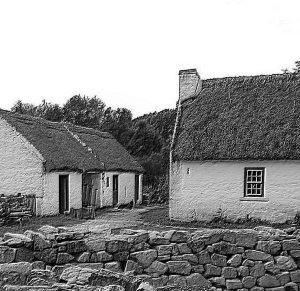
The Groba-Timrjazdwell in at least two of Rhudaur’s shires. There is talk of granting them a special region of their own but though the larger people of western Rhudaur are not that numerous they oppose any attempt to carve out a territory for the Little Folk. Indeed their numbers are not yet so great they need their own land. Lacking both ambition and numbers they are no threat to any of the northern kingdoms. If asked whether they would want to live under their own kings they laugh or stare at you in amazement. “Why should we want our own king?” they ask. “What would we do with a king?”
Indeed, if there were no kings among Men, the Little Folk would get along just fine. It is quite apparent they have always taken care of their own affairs without meddling in the affairs of others. They have few if any enemies in the wide world. They have neither love for nor discourse with dark creatures such as Orcs and Trolls. But neither do they seek out such foes for fame or fury.
Looking to the future the Little Folk say they feel safer in Rhudaur, despite its occasional conflicts with the other kingdoms and the wild creatures. One can almost feel the dread in their hearts should they look to the east and think of what lies beyond the mountains. They have come west for a purpose and perhaps forever. And it is that conviction which has led the loremasters of Rhudaur and Arthedain to ask if there not some great evil brewing in the Wilderland. If there is, it may not be long before the other tribes of Little Folk begin migrating over the mountains. Although their numbers are not great they may change the balance of power among the little kingdoms. And that is worrisome to a few far-sighted individuals here and there. But the Hasafotuns simply shrug and say, “If come they must, room will be found for them. They have no interest in wars.” And that may be the Little Folk’s saving grace.
# # #
Have you read our other Middle-earth Unplugged articles?

[…] From 1050 to 1300 the Harfoots (later joined by the Fallohides) lived in eastern Eriador between the Mitheithel (Hoarwell) river and the Weather Hills. From 1150 to 1356 the Stoors (who had come north through Dunland and Eregion) had lived in the Angle. Thus, for the first 150 years of their history in Eriador all the Hobbits appear to have been subjects of the Dunadan kingdom of Rhudaur. (NOTE: Be sure to check out our Middle-earth Unplugged article about Hobbits in Rhudaur: “Rhudaur and the Little Folk”.) […]